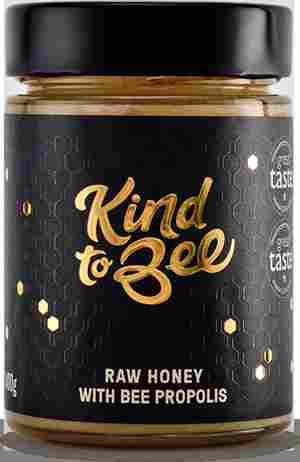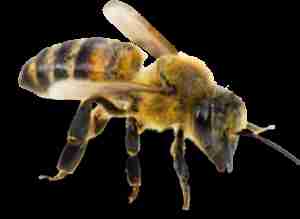The five things you need to know about Bee Propolis
RAW HONEY WITH PROPOLIS
We have scientifically created this precious immune defending honey, it starts with our premium raw honey and is carefully mixed with high quality all natural propolis, to boost this honey’s health benefits. Bee Propolis is a rich source of bioflavonoids and has antifungal and antibacterial properties. Propolis is the immune system of the hive and is the most fascinating bee product, as it creates a sterile environment in the beehive and protects it from germs, diseases and pathogens. Raw Honey with Propolis has a luxurious smooth and delicate creamy texture, with the pleasant aroma of propolis. The taste is sophisticated, like no other honey you have tried before and feels like light cappuccino foam.

How to take: as an immune booster we recommend to eat a teaspoon a day. It can be used in culinary applications but it should not be heated as this can degrade the benefits of propolis. Pairs beautifully with warm apple pie and pecan ice cream.
Tasting notes: Luxurious & Velvety
250g
kosher certified
ethically sourced
crafted in small batches by hand
raw and natural
monofloral honey
pesticides and chemicals free
suitable for vegetarians
Great Taste Award winner 2018, 2019, 2020
Store in a dry, cool and dark place. Refrigeration not recommended.
Honey should not be given to infants under 12 months of age.
What to do with all that propolis! – Colorado Beekeepers Association
The easy way to collect clean propolis is to use a propolis trap late in the summer, when bees are already wanting to propolize everything in sight. It looks a lot like a a queen excluder (but different), and fits on top of the uppermost hive body. Once the bees get it filled with propolis, the trap goes in the freezer to stiffen. Frozen propolis is brittle, and a couple of twists to the trap yield a nice little pile of small propolis “sticks”. I just tried one for the first time this year. Works great!

I also end up at the end of the year with a fist-sized or larger glob of propolis scrapings. These aren’t so clean. They contain wood chips, bee legs, beeswax, etc. This glob goes in the freezer, too, along with either a dedicated coffee grinder, or a mortar and pestle. Once well frozen, the propolis and tools come out of the freezer. Break off a small chunk of propolis, and put the rest back in the freezer. Just a couple of minutes in the mortar and pestle will yield a nice pile of propolis dust, up to pin head size. The finer you can get it, the cleaner you will be able to get it, and the more good stuff the alcohol will be able to pull out for the tincture. If you are using a coffee grinder, be aware that grinding for too long will heat the propolis, and make it very sticky.
Place the ground propolis into a square of cloth or paint filter. This gives you something to lift it out of the water with. Submerge in cool water, deep enough to allow the junk to float up. It will take a couple of minutes of stirring to get everything wet enough to work properly. Skim the junk off the surface of the water, and lift your now-clean propolis out using the square of cloth. Allow to drip, and air dry.
Propolis powder mixed with honey, at a ratio of 3 parts propolis to 7 parts of honey, is a great wound dressing. Supposedly, it will even heal a wound that already has gangrene. I used a 1:2 ratio of propolis/honey for the honey facial demonstation.
To make a tincture, add 1 part of propolis to 5 parts of oil, alcohol (like vodka), or water, depending on the intended use. Never use rubbing alcohol, which is poisonous. Shake the liquid and propolis jar twice daily for a minimum of two weeks, and strain. Alcohol does the best job of pulling the good stuff out of the propolis, and into the liquid for use. Alcohol, water, and oil all pull different constituents from the propolis. For a great mouthwash, you’d use a water tincture. For a body cream, an oil tincture would be used. Alcohol propolis tincture works well for use as a medicinal. Propolis is antibacterial, anti-fungal, anti-viral, and even anti-tumoral in some instances.
The five things you need to know about Bee Propolis
Honeybee collecting Green Propolis from the Baccharis dracunculifolia shrub in Brazil
What is Bee Propolis?
The term propolis comes from two Greek words, pro (which means for or in defense of) and polis (which means the city); thus, bee propolis means in defense of the city or beehive.
Bees harvest propolis from various plants, and it can vary in color from dark brown to green to red. Unlike honey or pollen, it does not come from flowers. It comes from secretions of trees or shrubs produced in the bark or the stems of new leaves. It is a resin that bees use as a glue or sealant around the hive. Bees also use propolis as an embalming agent for small animals that have entered the hive, bees killed, and are too big for them to remove. So, bees cover the animal, like a rodent, with propolis to prevent the decomposition process from affecting the colony. From there, scientists thought that this sticky substance could have antibacterial properties that have now been extensively studied, more on that below. If you are looking for a trust worthy brand of Bee Products? Visit our HummingBee Brand on Amazon.
The chemical backbone of a Flavone, a member of the big Flavonoid family, commonly found in Bee Propolis
Visit our Amazon Store for the whole HummingBee Bee Products line up
Propolis chemical structure
Propolis is composed of an array of natural chemical substances that vary depending on the propolis’s botanical origin; more on that later. Raw propolis is typically composed of 50% plant resins, 30% waxes, 10% essential and aromatic oils, 5% pollen, and 5% other organic substances. Different studies have identified more than 500 compounds in propolis, including phenolic components, terpenes, lipid-wax substances, beeswax, and other substances such as vitamins, proteins, amino acids, and sugars. Plant phenolics constitute the most abundant group of chemical components, including flavonoids, phenolic acids, and aldehydes, simple phenols and their esters, coumarins, stilbenes, and lignans (J.M. Alvarez-Suarez (ed.), Bee Products – Chemical and Biological Properties, 2017). From these, the flavonoid compounds and phenolic acids are the most abundant and have the most health benefits.
Honeybees collecting Red Propolis from a Mangrove plant in Brazil
Are all bee propolis the same?
As previously mentioned, bee propolis varies in function of botanical origin. It varies according to its physical (color, aroma, stickiness, etc.) and chemical profile. The most common one worldwide is brown propolis but the most renowned ones, especially in recent years, are the green and red propolis, both from Brazil. The green Brazilian propolis comes from the Baccharis dracunculifolia shrub, and bees collect the red propolis from Mangrove plants.
Still, any propolis has potential health benefits independently of color or botanical origin, as all of them contain flavonoids and other substances with bioactive functions. A bioactive compound is a substance that is not essential for an organism’s normal metabolic process, but its consumption provides potential health benefits. Further information about Brazilian Green Propolis: Plant Origin of Green Propolis: Bee Behavior, Plant Anatomy and Chemistry, and on Red Propolis: Chemical composition and biological activity of a new type of Brazilian propolis: Red propolis
Honey bees starting to seal the gap with Propolis
Can propolis be eaten?
Yes, it can; however, you cannot consume it raw, as bees collect it. Raw, is a hard, strong-tasting, sticky substance that is not very palatable. For you to eat it, it has to be extracted and diluted either on water, alcohol, or a mixture of both. This procedure has to be done at a laboratory level where specific systems and times are in place, so a consistent product is obtained time and time again.
After it is extracted and in liquid form, it can be kept and bottled as it is (it would have to be further diluted in water to be drinkable as it will be quite strongly flavored), it can be mixed with honey to obtain a combination formula, mixed with other herbal extracts and water for a throat and mouth spray or it can be lyophilized (dehydration under freezing conditions that preserve all the health properties) to be made into pills or capsules. So, how to use bee propolis? It is considered a supplement, and thus there are no specific recommendations; the best guideline would be to consume it regularly in the presentation you prefer.
Diagram illustrating the formation of Reactive Oxygen Species (ROS). When the oxygen molecule accepts an electron, it becomes a superoxide radical which, upon further electronation, produces peroxide. The latter can undergo further reactions with electrons and protons to produce potent hydroxyl radicals. Antioxidants act by donating protons (H+) to free radicals, leading to the formation of water. Credit: (J.M. Alvarez-Suarez (ed.), Bee Products – Chemical and Biological Properties, 2017)
Which are the health benefits of Bee Propolis?
The studies on Bee Propolis are extensive as it has many substances with potential health benefits. The main effects that have been found are Antioxidant activity (the scavenging of free radicals that can potentially produce cell damage), Antibacterial, Antiviral, Antiprotozoal, Antihelmintic and Antifungal properties, Wound Healing properties, Antiulcer activity, helps in the treatment of diabetes and cardiovascular disease, and Anticancer, and Immunomodulatory effects. The literature on all these is extensive; however, you can find it summarized in this book (J.M. Alvarez-Suarez (ed.), Bee Products – Chemical and Biological Properties, 2017)
Bonus: Does bee propolis expire or goes bad?
Bee propolis is a very hardy substance that does not contain the nutrients that microorganisms like molds, yeasts, and bacteria feast on, like proteins and sugars. Additionally, it also lacks moisture in its raw form, so these organisms find it hard to grow on it. Moreover, it is rich in antibacterial chemicals that also fight off microorganisms, and when processed, it also usually has alcohol, so it is shelf-stable for a very long time. In conclusion, it would be tough to find expired propolis.
If you are also interested in learning about the health benefits of bee pollen and honey just click on the links to read more.
Also, check out our HummingBee Bee Propolis Throat Spray in case you are interested, or our entire lineup of Bee Products on Amazon.
Finally, we have recently been featured on GoSolo magazine, find the whole article here.

